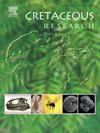Palaeoenvironmental and palaeoecological inferences from inclusions in vertebrate omnivore coprolites from the Upper Cretaceous Lameta Formation of central India
IF 1.7
3区 地球科学
Q1 GEOLOGY
引用次数: 0
Abstract
Fossil faeces, or coprolites, offer unique insights into prehistoric food webs and ecosystems as well as direct evidence of the diet of faecal producers. We collected hundreds of coprolites from the Upper Cretaceous Pisdura site of Central India. Type A morphotype coprolites from the Lameta Formation of Pisdura, Maharashtra, India, have been found to have a rich microbiota with unique plant fossils. When macerated fractions were analysed using scanning electron microscopy, seven ostracod taxa were found, together with diatoms (Aulacoseira sp.), a charophyte (Microchara sp.), and sponge spicules. Thin sections of one of the coprolites also revealed a large number of likely chrysophytes. One of the cut slab specimens of the coprolite contains an insect body part with a partially intact wing. In addition, a review of previous studies reveals that spores, fungal remnants, thecamoebians, testate amoebae, and plant remains are also present in the Type A coprolites. For the Lameta Formation in Pisdura, the microbiota provide evidence for a Maastrichtian age and fluvio-lacustrine depositional conditions and other varied environments. Much of the plant detritus is not identifiable, but some tissues can be recognised, such as Poaceae cuticle, spores, wood, cones, seeds, phytoliths, and silica-replaced leaf laminae. Chemical analyses show that the coprolites have a phosphorus content of between 12.2 and 16.2 weight% which suggests a carnivorous habit. Thus, these Type A coprolites reveal that the ancient faecal producers not only consumed aquatic microbiota and abundant plant tissues but also likely ingested soft animal tissues as well. Although water input may have been the source of testate amoebae, diatoms, sponge spicules, and algae remnants, the peculiar pairing of a phosphatic composition with dietary residues from plants and microbiota suggests that the ancient faecal producers were omnivores. This feeding habit implied by the Type A coprolites indicates that previous attributions to herbivorous titanosaurs are not well-supported.
印度中部上白垩世Lameta组杂食性脊椎动物粪化石包裹体的古环境和古生态推断
粪便化石或粪化石为史前食物网和生态系统提供了独特的见解,也为粪便生产者的饮食提供了直接证据。我们从印度中部的上白垩纪Pisdura遗址收集了数百具粪化石。在印度马哈拉施特拉邦Pisdura Lameta组的A型粪化石中发现了丰富的微生物群和独特的植物化石。当用扫描电子显微镜分析浸泡后的馏分时,发现了7个介形虫类群,以及硅藻(Aulacoseira sp.),绿藻(Microchara sp.)和海绵针状体。其中一个粪化石的薄片也显示出大量可能的绿藻。粪化石的一个切割板标本包含昆虫的身体部分和部分完整的翅膀。此外,回顾以往的研究表明,孢子,真菌残留物,变形虫,遗存变形虫和植物遗骸也存在于a型粪化石中。对于Pisdura的Lameta组,微生物群提供了马斯特里赫特时代和河流湖泊沉积条件以及其他变化环境的证据。许多植物碎屑无法识别,但一些组织可以识别,如禾科角质层、孢子、木材、球果、种子、植物岩和硅代替的叶层。化学分析表明,粪化石的磷含量在12.2%到16.2%之间,表明它是一种食肉动物。因此,这些A型粪化石表明,古代粪便生产者不仅消耗水生微生物群和丰富的植物组织,而且还可能摄入软动物组织。虽然水的输入可能是遗尿变形虫、硅藻、海绵针状体和藻类残留物的来源,但磷酸盐成分与植物和微生物群的膳食残留物的特殊配对表明,古代粪便生产者是杂食动物。A型粪化石暗示的这种摄食习惯表明,先前将其归为草食性泰坦龙的说法并不充分支持。
本文章由计算机程序翻译,如有差异,请以英文原文为准。
求助全文
约1分钟内获得全文
求助全文
来源期刊

Cretaceous Research
地学-地质学
CiteScore
4.10
自引率
19.00%
发文量
235
审稿时长
12 weeks
期刊介绍:
Cretaceous Research provides a forum for the rapid publication of research on all aspects of the Cretaceous Period, including its boundaries with the Jurassic and Palaeogene. Authoritative papers reporting detailed investigations of Cretaceous stratigraphy and palaeontology, studies of regional geology, and reviews of recently published books are complemented by short communications of significant new findings.
Papers submitted to Cretaceous Research should place the research in a broad context, with emphasis placed towards our better understanding of the Cretaceous, that are therefore of interest to the diverse, international readership of the journal. Full length papers that focus solely on a local theme or area will not be accepted for publication; authors of short communications are encouraged to discuss how their findings are of relevance to the Cretaceous on a broad scale.
Research Areas include:
• Regional geology
• Stratigraphy and palaeontology
• Palaeobiology
• Palaeobiogeography
• Palaeoceanography
• Palaeoclimatology
• Evolutionary Palaeoecology
• Geochronology
• Global events.
 求助内容:
求助内容: 应助结果提醒方式:
应助结果提醒方式:


